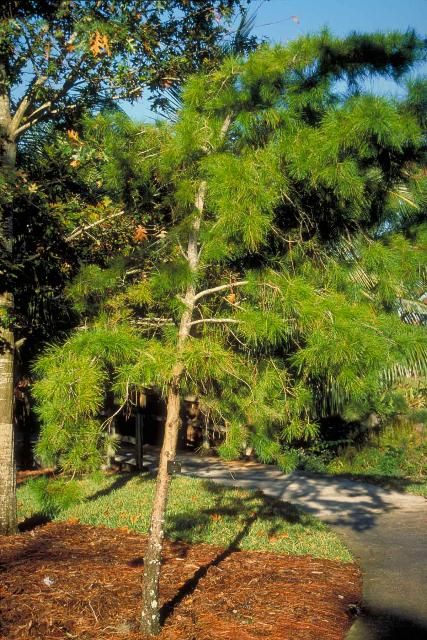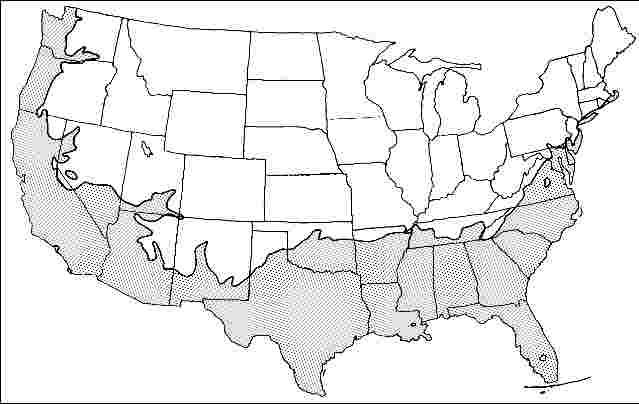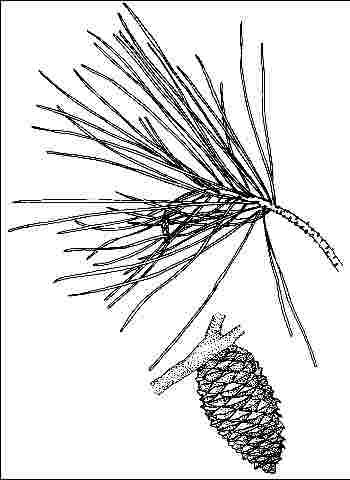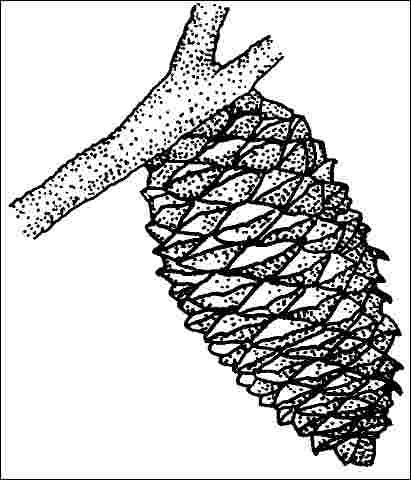Introduction
This native North American pine is usually seen as a scrubby tree, capable of reaching 100 feet in height but more often seen 15 to 40 feet tall, with a slow growth rate. The supple, evergreen leaves and the plant's ability to thrive in almost any soil make Sand Pine a good choice for use as a Christmas tree, with proper shearing. The 2 to 3.5-inch-long, spiny cones persist for quite a while on the tree, often becoming embedded in the wood of the twigs.

Credit: Ed Gilman
General Information
Scientific name: Pinus clausa
Pronunciation: PIE-nus KLAW-suh
Common name(s): Sand Pine
Family: Pinaceae
USDA hardiness zones: 7A through 10B (Fig. 2)
Origin: native to North America
Invasive potential: weedy native
Uses: specimen; shade; reclamation; highway median; Christmas tree
Availability: somewhat available, may have to go out of the region to find the tree

Description
Height: 25 to 40 feet
Spread: 15 to 25 feet
Crown uniformity: irregular
Crown shape: oval
Crown density: open
Growth rate: slow
Texture: fine
Foliage
Leaf arrangement: alternate (Fig. 3)
Leaf type: simple
Leaf margin: entire
Leaf shape: needle-like (filiform)
Leaf venation: parallel
Leaf type and persistence: fragrant, evergreen, needled evergreen
Leaf blade length: 2 to 4 inches
Leaf color: green
Fall color: no color change
Fall characteristic: not showy
Flower
Flower color: yellow
Flower characteristics: not showy

Fruit
Fruit shape: oval, cone
Fruit length: 1 to 3 inches
Fruit covering: dry or hard
Fruit color: brown
Fruit characteristics: attracts squirrels/mammals; not showy; fruit/leaves a litter problem

Trunk and Branches
Trunk/bark/branches: branches droop; not showy; typically one trunk; thorns
Pruning requirement: little required
Breakage: susceptible to breakage
Current year twig color: brown
Current year twig thickness: medium
Wood specific gravity: 0.48
Culture
Light requirement: full sun, partial sun or partial shade
Soil tolerances: clay; sand; loam; slightly alkaline; acidic; well-drained
Drought tolerance: high
Aerosol salt tolerance: high
Other
Roots: not a problem
Winter interest: no
Outstanding tree: no
Ozone sensitivity: unknown
Verticillium wilt susceptibility: resistant
Pest resistance: resistant to pests/diseases
Use and Management
The trunks on Sand Pine are rarely straight. The tree usually grows with a portion of the crown missing or with a lean to one side. This may contribute to the unpopularity of the tree in the landscape trade. However, this attribute can make it well suited for planting as an accent in any large scale landscape. It is especially useful and attractive when planted in a lawn area as a single specimen. It certainly has its place in reclamation sites as a colonizer of poor soils. The tolerance to dry, sandy soils should make this tree adaptable to conditions created near asphalt and other hot areas in urban landscapes.
Sand Pine should be grown in full sun on any well-drained soil. The tree is highly drought- and salt-tolerant.
Propagation is by seed.
Pests and Diseases
No pests or diseases are of major concern.